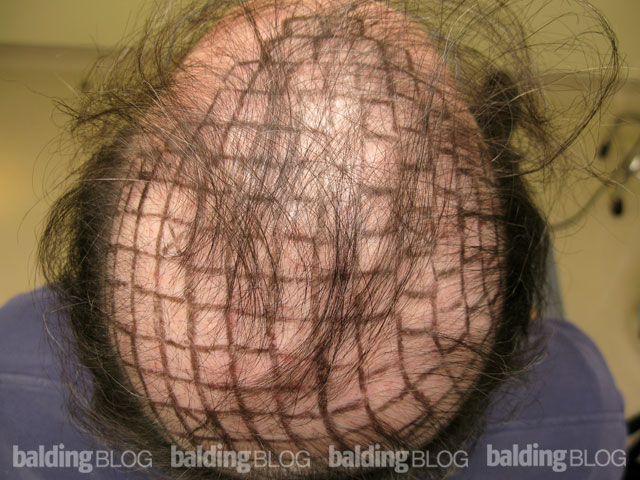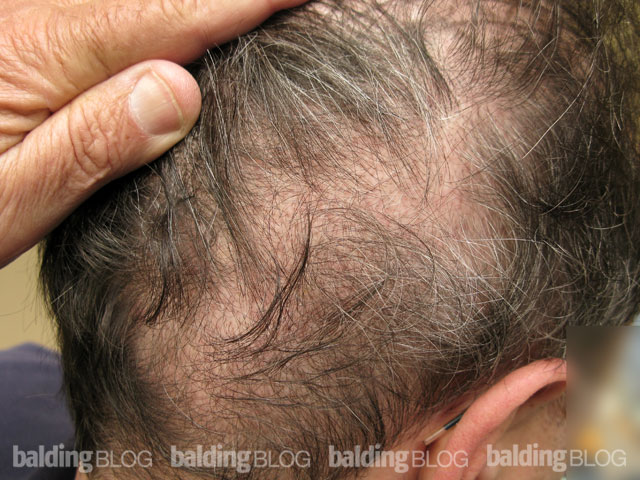How Many FUE Grafts Actually Grew? (with Photos)
A man came to see me last week with a problem following his hair transplant at another clinic over a year ago. The surgeon told him that 6600 grafts were transplanted (in three sessions) using the follicular unit extraction (FUE) technique, which he guaranteed has a yield of over 90%. The patient wanted to know if his surgery actually reflected 6600 grafts, so at the patient’s request, we counted the actual grafts that grew. We divided up his head into 1cm square units and then counted the individual grafts inside those squares. The count yielded 2092 grafts of which approximately 50% had only one-hair and 50% had two-hairs, totaling approximately 3100 individual hairs. The hairs did not look very healthy, but the patient had fine hair in his donor area, so I suspect that the fullness reflected the low volume of each hair that survived.
I actually had the opportunity to measure his density before he decided to have his surgery with another doctor. His initial preoperative donor density measured 2.4 hairs per mm square. In my experience this type of donor density usually yielded about 15% one-hair grafts, 65% two-hair grafts, and the rest would be three-hair grafts. Estimating the hair count from the 6600 grafts he expected to grow, he should have had hair growth that would reflect (1) approximately 3960 hairs from three-hair grafts (20% of the 6600 grafts), (2) 8580 hairs from two-hair grafts (65% of the 6600 grafts) and (3) 990 single hairs (reflecting 15% from one-hair grafts)… for a total of 13,530 hairs that would have grown from a 100% successful harvest. Estimating an FUE yield of 90% (a reasonable estimate for FUE and his surgeon’s guarantee of that amount) from a projected successful hair count from the 6600 grafts, I would reduce that count to 12,204 hairs (90% of the 13,500 hairs estimated above). He should compare the actual hair count we obtained in the counting process of approximately 3100 hairs which reflects a loss of 9104 hairs. The hair count therefore reflected a substantial reduction in the hair yield of those grafts that grew when compared to what should have grown. When one would count the grafts that did not grow, the death rate of the hairs was almost three times what did grow.
Where did those missing hairs go? I suspect that they were killed at the time of the FUE either through drying of the grafts during placement, trauma from the technicians placing the grafts, or transection of the grafts (a common problem in those surgeons who really do not have mastery of the FUE technique).
Below left: Lines drawn to divide the area for the graft count; Below right: Sparse donor area. Click photos to enlarge:


This patient shows that he probably did have an attempted harvest of 6600 grafts, as his donor area is very sparse and very see through (which is very unusual for a person with his original density). The problem is, almost his entire donor supply was wiped out. He is no longer a hair transplant patient candidate for additional transplants, even if that surgeon agreed to do the surgery at no charge to that patient. Short of cloning hair, he has no real options… and as we all know, cloning isn’t close to being available.
I have made many posts discussing the false/misleading promotion of a surgeon’s skills with the FUE technique. The surgeon that did this terrible work has a worldwide reputation claiming expertise with FUE. Problems like this not only occur with the FUE technique, but in traditional strip harvesting where the surgeon does not get graft growth. Look through some of the past posts about this type of failure and you will see that this particular patient’s experience is unfortunately far from unique. Then to add to the current problems with inexperienced surgeons, there are new FUE systems/tools coming available that are promoted to allow any surgeon to perform this artistic procedure without any prior experience in the field. Things like this, combined with the false advertising and cut-throat pricing, has turned the hair transplant business into a frequent scam, where doctors promise the balding man a world of hair that can’t be delivered at the expense of many, many balding victims. I feel like I’m just repeating myself, but I really can’t say this enough — hair transplantation is a cosmetic procedure on your scalp! It is right there for everyone to see! If funds are tight, you might want to just hold off until you have the money to have the procedure done correctly by a competent, experienced surgeon… otherwise, you’re running the risk of major permanent problems in the future. This isn’t buying a car. You can’t turn around and sell it if you don’t like it. Hair transplantation is for life.

Please let us know who this Dr. is. I know you do not want a reputation of badmouthing Drs. — but for the benfit of those of us who do not want this type of result, please mention it — it is not badmouthing, it is warning. At least the State where this Dr. practices. What good is a warning, if it isn’t linked to a culprit?
We maintain a policy to not slam specific doctors. I don’t want to open myself up to any legal action and honestly, I’d prefer to focus on revealing the scams some doctors pull and encouraging users to do their own research on any doctors they are considering.
We hold open house events each month where any patient can come in and say whatever he/she pleases in front of a very interested audience. I would challenge other doctors to have this same policy, which would obviate the problems that this patient had.